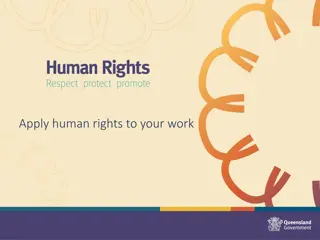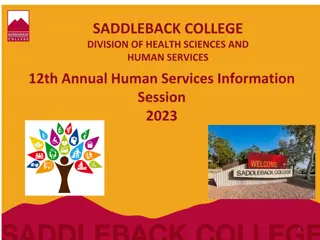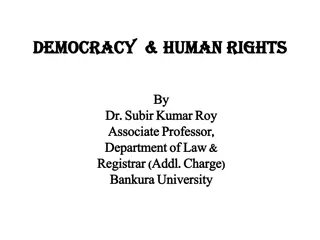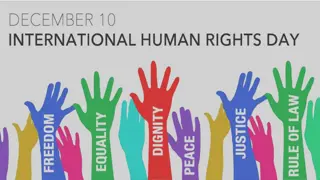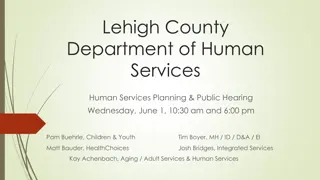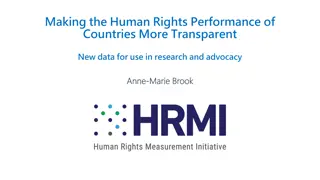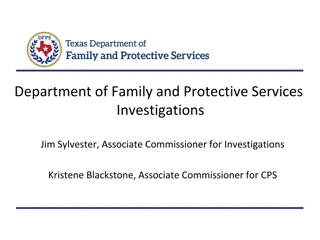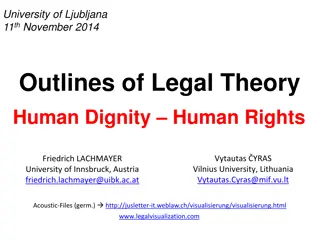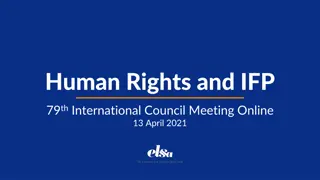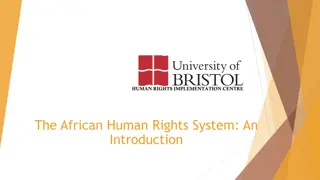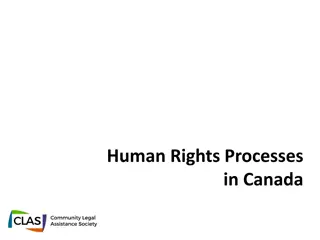
DFPS Agency Overview and Statistics for Human Services Committee
Delve into the core functions of the Texas Department of Family and Protective Services (DFPS) including Statewide Intake (SWI), Adult Protective Services (APS), Child Protective Investigations (CPI), and more. Explore key statistics and numbers for FY2025 to understand the agency's impact on protecting vulnerable populations. Witness the commitment of DFPS to safeguarding individuals from abuse, neglect, and exploitation through various programs and initiatives.
Download Presentation

Please find below an Image/Link to download the presentation.
The content on the website is provided AS IS for your information and personal use only. It may not be sold, licensed, or shared on other websites without obtaining consent from the author. If you encounter any issues during the download, it is possible that the publisher has removed the file from their server.
You are allowed to download the files provided on this website for personal or commercial use, subject to the condition that they are used lawfully. All files are the property of their respective owners.
The content on the website is provided AS IS for your information and personal use only. It may not be sold, licensed, or shared on other websites without obtaining consent from the author.
E N D
Presentation Transcript
Presentation to the House Human Services Committee Stephanie Muth DFPS Commissioner Audrey O'Neill DFPS Deputy Commissioner forPrograms March 4, 2025
DFPS Agency Overview Core Functions Statewide Intake(SWI) Operates 24 hours a day, seven days a week, as the centralized point of intake for reporting suspected incidents of abuse, neglect, and exploitation and childcare licensing standards violations. Adult Protective Services(APS) Protects adults living in their own homes who have disabilities or who are 65 years old or older by investigating reports of abuse, neglect, and exploitation and providing short-term services. Child Protective Investigations(CPI) Investigates reports of abuse, neglect, and exploitation, including those within certain residential facilities. Child Protective Services (CPS) Assesses and places children in foster care when they are not safe in their own homes, and for ensuring the best permanency outcomes for children in care. 2
DFPS By TheNumbers FY2025 (YTD) FY2022 FY2024 StatewideIntake Turnover CallAbandonment Hold Times 15.2% 27.5% 7.3minutes 12.4% 22.8% 6.2minutes 7.5% 22.6% 6.2minutes Adult ProtectiveServices Turnover Average Daily Caseload Case InitiationTimeliness 33.9% 26.3cases 98.2% 29.1% 24.5cases 98.4% 22.3% 23.4cases 98.4% Child ProtectiveInvestigations Turnover Average Daily Caseload P1 Face-to-Face Contacts Actual/Attempted P2 Face-to-Face Contacts Actual/Attempted Average Time to Case Closure 45.5% 17.1cases 90.1% 89.2% 45.5 days 32.6% 9.6cases 90.0% 91.2% 32.9 days 31.3% 9.1cases 90.5% 91.8% 28.8 days 3
DFPS By TheNumbers FY2025 (YTD) FY2022 FY2024 Child ProtectiveServices Children in Substitute Care CVS Caseworker Turnover (Excluding CBC) CVS Average Daily Caseload FBSS Average Daily Caseload Children with Permanency in 12 months Children Without Placement (CWOP) 19,049 children 29.3% 19.5 cases 4.8cases 27.1% 61 children 15,297 children 34.8% 15.2 cases 9.8cases 30.2% 16 children 15,666 children 22.5% 14.0 cases 9.4cases 27.8% 20 children KinshipInitiatives Children in KinshipSettings Children with Kinship as First Placement 44.2% 37.2% 40.5% 37.1% 41.8% 37.0% Community Based Care Children in CBC Responsibility (Aug. 31) Stage I Implementation Stage II Implementation Stage IIIImplementation 25.1% kids incare 4regions 3regions 0regions 49.4% kids incare 0regions 4regions 4regions 49.0% kids in care 0regions 4regions 4regions 4
Statewide Intake Statewide Intake (SWI) assesses all reports of abuse, neglect, or exploitation, and routes them to the right program for investigation. SWI operates 24-hours a day, 7 days a week, 365 days a year. Responsibilities of SWI include receiving reports for: Child abuse, neglect and exploitation in the child s own home or in child-care facilities or treatment centers Abuse, neglect, and exploitation of the elderly or adults with disabilities living athome Abuse, neglect, and exploitation of adults and children who live in state facilities or are enrolled in programs for people with mental illness or intellectual disabilities Reports of abuse, neglect, or exploitation of children, the elderly, or people with disabilities to SWI, can be made by calling the hotline, making an online report (e-report), sending a fax, or mailing in your concerns. Page5
Statewide Intake: Calls and Hold Times data sources: DFPS FY24_Q4 Report Card Page6
Statewide Intake: Reporter Sources Everyone in Texas is mandated to report child abuse, neglect and exploitation. Most reports to Statewide Intake are from professional reporters. In FY24 the top four reporters were: Medical Personnel 20.8% Law Enforcement 16.0% School Personnel 15.9% Relatives 9.2% data sources: fps_int_01, fps_int_swi_02, fps_swi_03, fps_int_swi_04, fps_int_swi_06, fps_int_swi_07, swi_19 Page7
Types of Child Protective Investigations Child Protective Investigations (CPI) conducts investigations in homes, schools, and licensed settings. The severity and location of the allegation determines which type of investigation will be initiated and who will investigate. FY24 INV, AR, and CCI Investigations Closed Opened 236,662239,297 Child Protective Investigations (INV) investigates allegations of child abuse, neglect and exploitation in family settings. Alternative Response (AR) handles cases of abuse or neglect that initially present with less immediate safety or risk issues. Child Care Investigations (CCI) investigates allegations of child abuse, neglect and exploitation in licensed settings, both residential and daycare. 6,598 5,415 INV &AR CCI Page8
Intakes Referred to CPI for In-Home Investigation 350,000 Intakes referred to CPI for In-home investigation (FY 2013 FY 2024) 300,000 286,689 Total Annual Investigation Intakes Priority 1 Investigation 256,103 250,000 238,941 230,439 220,408 201,918 200,000 Priority 2 Investigation 192,519 170,662 163,154 161,726 152,456 150,000 135,538 P1 and P2 investigations must be initiated within 24 hours and 72 hours, respectively. 100,000 61,434 58,895 54,745 52,358 51,840 50,000 39,656 0 2013 2014 2015 2016 2017 2018 2019 2020 2021 2022 2023 2024 data source: int_03: CPS Intakes by Allegation and Priority Page 9
CPI InvestigationDispositions Investigation Dispositions (FY 2024) At the end of an investigation, the caseworker assigns a disposition to each allegation identified in aninvestigation: 34,394, 24% Ruled Out Reasonable to conclude that the abuse, neglect, or exploitation has not occurred. Reason to Believe Abuse, neglect, or exploitation occurred based on a preponderance of the evidence. 16,104, 11% Unable to Complete The investigation cannot be concluded. For example, the family could not belocated. 1,628, 1% 92,063, 64% Unable to Determine Not enough to determine whether the alleged abuse or neglect occurred or whether the alleged perpetrator is responsible for the abuse orneglect. Reason To Believe Unable to Complete Ruled Out Unable to Determine 10 Data Source: Data Warehouse: INV_CPS_06,exd1_03 Note: Total Open and Closed INV/AR includes Admin Closures andMerges
Child Protective Services Family-Based Safety Services (FBSS) Conservatorship (CVS) Substitute care is provided from the time a child is removed from their home and placed in DFPS conservatorship until they return home safely or are permanently placed in another living arrangement and a court dismisses the state s conservatorship When a child's safety can be reasonably assured, CPS provides in-home services to help stabilize the family and reduce the risk of future abuse or neglect Page11
FBSS: Families and Children Families and Children in FBSS services on August 31 of Each Year 40,000 34,656 35,000 31,873 31,858 30,000 26,655 26,490 25,156 25,000 19,884 18,488 Children Families 20,000 15,000 12262 11568 11,496 11072 10,971 10218 9736 9444 10,000 7471 6992 4385 4116 5,000 0 2015 2016 2017 2018 2019 2020 2021 2022 2023 2024 Data Source: Databook, FBSS; Children and Families in Services on August 31 Report Run Date:1/10/25 Page12 12
Conservatorship: Child Census Children in DFPS Legal Responsibility on August 31 of Each Year For Children 0-17 35,000 30,013 29,202 28,621 28,084 30,000 27,239 27,220 26,164 25,000 19,974 20,000 17,383 16,035 15,000 10,000 5,000 0 2015 2016 2017 2018 2019 2020 2021 2022 2023 2024 Data Source: Data Warehouse SA_05, Warehouse Data As of: 12/07/24 Report Run Date:1/10/25 Page13
CPS: Conservatorship Census Most children in DFPS care reside in family-like home settings. Of the 15,666 children in care (ages 0-17) at the end of December 2024, 12,882 (82.2%) resided in a family-like home setting: 9,207/ 58.8% were in fostercare 6,459/ 41.2% were in other types of substitute care 785/ 5.0% GRO ChildcareOnly 6,737/ 43.0% FosterFamily Homes 5,962/ 38.1% Kinship Care (unverified) = Family-Like Setting 314/ 2.0% Independent Living and Other 1,103/ 7.0% Residential TreatmentCenters 325/ 2.1% EmergencyShelters 183/1.2% AdoptiveHomes 20/ 0.1% ChildrenWithout Placement 237/ 1.5% Other FosterCare 14
Exits From Care Exits from DFPS Legal Custody (FY 2024) Most children are reunified with their parents or remain permanently with kin. Others are adopted through the foster care system. Aged Out / Other 961 (9%) Returned Home Non-Relative Adoption 1,861 (17%) 3,478 (32%) Kinship 4,525 (42%) * Relatives include permanent custody to relative/kinship through fictive kin PCA and Non PCA, as well as consummated adoption with relatives. Data Source: Data Warehouse CPS_pp_20, Warehouse Data As of: 11/07/24 Report Run Date:1/10/25 Page15
Post Adoption Services Provided by DFPS Assists with coping, adjusting and preventing adoption break down. Case Management and ServicePlanning Providers meet with families, asses their needs and develop an individualized services plan; case managers maintain regular contact with the family, assess progress and assist in accessing services. Parent Training and SupportGroups Providers offer a variety of on-line and in person meetings with other adoptive parents as well as experts specializing in trauma, parenting teens and addressing specific behavioral and mental health issues. Respite Care and Crisis Intervention Providers can use up to 10% of their budget for respite services so families can select a friend, family member or another adoptive parent to provide respite, and are available around the clock to assist in locating and accessing emergency services. Residential PlacementServices Assist adoptive parents in completing searching for placement, completed the application for placement, and providing financial support. 16
Adult Protective Services APS investigates allegations of abuse, neglect, and financial exploitation and provides protective services to people who meet any of the following criteria: Age 65 or older Age 18-64 with a mental, physical, intellectual, or developmental disability that substantially impairs a person's ability to live independently or provide for their own self-care or protection APS investigations focus on individuals living in a home setting. Investigations include self-neglect or abuse and neglect by family members or caretakers. Assistance and services provided by APS are completely voluntary. Page17
APS: Cases and Clients Served In FY 23, APS received 82,327 reports of abuse, neglect, or exploitation of adults 65 and older, and 37,724 reports of abuse, neglect, or exploitation of adults between the ages of 18- 64. In FY24 38,989 clients received services from APS 16,498 received purchased client services APS Top Purchased Client Services (FY2024) 3000 $2,500,000.00 2500 $2,000,000.00 2000 $1,500,000.00 1500 $1,000,000.00 1000 $500,000.00 500 0 $0.00 18 Clients Served Amount Spent
Major DFPS Initiatives Community-Based Care Children Without Placement (CWOP) Texas Child-Centered Care (T3C) 19
Community-Based Care Senate Bill 11 (85R) transformed Foster Care Redesign into the model known today as Community-Based Care (CBC) CBC is a community-based approach to meet the unique needs of families and children by contracting with a nonprofit or governmental agency to provide direct case management to: Prevent entry into foster care Reunify and preserve families Ensure child safety, permanency, and well-being Reduce further referrals of children and families to DFPS Page20
CBC: Implementation Stages StageI StageII Foster Care NetworkDevelopment PlacementServices All Stage I Duties StageIII Case ManagementServices Child & Adolescent Needsand Strengths (CANS)Assessment Plan of Service for Children &Families Coordinated Child Plan ofServices Stage I and Stage II Duties Purchased Services forFamilies Family Purchased Services for Childrenand Youth Provides financial incentive andremedies based on performanceoutcomes ReunificationServices KinshipServices Preparation for Adult Living (PAL)for youth in paid fostercare Note: Incentives distributed must be reinvested to improve the quality ofcare to youth Transitional Living Services - PAL forall youth DaycareCoordination Interstate Compact on the Placementof Children Adoption and Post-Adoptionservices 21
Community-Based Care Expansion, Contd. Currently, about 50% of children in conservatorship are served by seven SSCCs. By 2029 , all of Texas will be served by CBC: SSCC January2023 January2025 Saint Francis(1) Stage II (March 2022) Stage III 2INgage (2) Stage II (June 2020) Stage III Our CommunityOur Kids (3W) Stage II in southern7 counties (March 2020) Stage II in Cooke, Denton, Wise Stage III in southern 7 counties EMPOWER (3E) Procurement Stage II 4Kids4Families(4) Procurement Stage II Texas FamilyCare Network(5) Procurement Stage II Belong(8B) Stage II (October 2022) Stage III Regions 6A, 6B, and8A Pre-Procurement Planning Procurement 22
Children Without Placement (CWOP) Total Children Without Placement Per Month 450 417 400 350 300 257 239 250 190.9 200 159 150 106.5 95 78 100 54 50 26 50 13.6 0 22-Jul 23-Jul 24-Jul 21-Aug 22-Jun 22-Aug 22-Oct 23-Jun 23-Aug 24-Jun 24-Aug 23-Apr 24-Apr 21-Sep 22-Apr 22-Sep 24-Sep 22-Feb 23-Feb 24-Feb 21-Oct 22-Jan 23-Jan 23-Oct 24-Jan 24-Oct 23-Mar 21-Dec 22-Mar 22-Dec 23-Sep 23-Dec 24-Mar 22-May 23-May 24-May 21-Nov 22-Nov 23-Nov 24-Nov 21-Jul Total Unique Children Average Daily CWOPCensus 23 A child without placement event refers to when a child or youth was without placement for at least two consecutive, uninterrupted nights. If a youth goes missing during a child without placement event, the youth will be in a missing status rather than a child without placement event to ensure protocols are followed to ensure the safe of a youth. If the youth returns from the missing event, a new event starts after at least two consecutive, uninterrupted nights. data source: CWOP Placement Tracker as of 10/2/24
Children Without Placement Children WithoutPlacement FY 2024 N=561 Children Gender Age Male 50% Female 50% 0 to9 5% 14 to 15 31% 16 to 17 43% 10 to13 21% 39% of all children who had a CWOP event in the timeframe had been in conservatorship for less than one year 42% of all children who had a CWOP event in the timeframe were removed due to Refusal to Accept Parental Responsibility 24 For childrenwith multipleevents,earliesteventintime periodwas used for analysis.Datasource: CWOPPlacementTracker as of 1/14/25
Children Without Placement Children without placement have complex needs Top 5 Child Characteristics/Needs FY 2024 N=1,119 Events PhysicalAggression 88% PsychiatricHospitalization 83% Runaway 75% Juvenile JusticeInvolvement 69% SuicidalIdeation 66% 25
Children Without Placement Interventions System Efforts Strategic System Wide Efforts DFPS centralized functions essential to finding placement solutions, surveyed providers to understand limits to capacity expansion, developed a community resource guide to help families in need of behavioral health support, and received funding to expand monitoring to more youth in Texas. InteragencyCollaboration DedicatedStaffingandFacility In April 2024, DFPS began using Ferne, an unused RTC, as a CWOP location for boys ages 13-17. The dedicated staff develop trust with the youth and help to prepare them to successfullymoveto placementby: establishinga pattern ofpositive behaviorand encouraging youth who previously rejected placement be active in identifying and expressing their placement priorities. Individual Child IntensiveFocus Convenes representatives from relevant state agencies and partners to use collective resources, knowledge, and expertise to address gaps in services. Resulting in a reduced number of youth in unlicensed placements; enhanced safety, stability, and well- being of affected children; and improved collaboration and communication among state and partneringagencies. Conducts an intensive daily meeting that fosters accountability and commitment among all participants to ensure the safety and well-being of youth. Utilizes child specific programs to identify and address mental and behavioralhealth. Intensive Psychiatric Stabilization Programs Partnering youth withmentors IndividualizedTherapies 26
Children Without Placement Youth Who Experienced CWOP Between March 9 August 31, 2024 The child protection system alone cannot meet the complex needs of a small subset ofyouth 284 youth experienced 2+ consecutive nightsof child watch We identify placements for most youth with complex needs 43% experienced a subsequent child watch episodeafter that initialepisode Placements are difficult to maintain due to behavioral health needs On average,youth experienced 3.2 subsequent child watchepisodes 27 Source: DFPS (as of1/14/25)
Texas Child-Centered Care Texas Child-Centered Care (T3C), also formerly known as Rate Modernization, represents a complete transformation of the foster care system. T3C replaces the 40-year-old rate structure with the following: Foster Care placements informed by an individual assessment. Clearly defined service packages designed to meet the individual needs of children in care. Rate methodology that aligns the cost of care to quality foster care services. Continuous quality assurance and improvement structure. 28
The Path toT3C 86th Regular Session(2019) General Appropriations Act (GAA), Special Provision 32 required HHSC, in consultation with DFPS, to evaluate the existing foster care rate methodology. 87th Regular Session(2021) The GAA, Special Provision 26, directed DFPS, with the assistance of HHSC, to develop an alternative reimbursement methodology for foster care and CBC rates, including aligning rates to clearly defined program models. 88th Regular Session(2023) The GAA included funding directed to the implementation of and new rates paid under the T3C System. January 2025 Providers transition to T3C begin serving children. September2027 All providers must be transitioned to T3C. 29
Benefits of T3C Restructuring the service delivery model through Thesystem will Resulting in Provider credentialing for clearly defined service packages Match children to providers that willbest meet their needs Improved experience for all children, youth, & young adults Develop a UniversalAssessment Process comprehensive network of quality services Provide method-based compensation for providers &caregivers Payment for service packages based onchild needs 30
The New T3C System FOSTER FAMILY HOME Add-On Services 1. 2. 3. 4. 5. 6. 7. 8. 9. T3C Basic Foster Family Home Care Substance Use Support Short-Term Assessment Services Mental & Behavioral Health Sexual Aggression/Sex Offender Complex Medical Needs Human Trafficking Victim/Survivor IDD & Autism T3C Treatment Foster Family Service Transition Youth Services Pregnant& Parenting Youth Kinship Care Children are interviewed/ assessed usingthe CANS tool. GRO Tier I 1. 2. 3. 4. 5. 6. 7. 8. 9. T3C Basic Child Care Operation Pregnant & Parenting Youth Sexual Aggression/Sex Offender Substance Use Treatment Emergency AssessmentCenter Complex Medical Needs Mental & Behavioral Health IDD & Autism Human Trafficking Victim Treatment The Universal Assessment CANS Assessment results are usedto inform the child s Recommended ServicePackage. Services to support transition to own home/kinship/ foster familyhome GRO Tier II 1. 2. 3. 4. 5. 6. Sexual Aggression/Sex Offender Substance Use Stabilization Aggression & Defiant Disorder Complex Mental Health Stabilization Complex Medical Stabilization Services Human Trafficking Victim Stabilization Services to support youth with highest acuityneeds Third-party reviewrequired 31
DFPS Data Overview For more information regarding DFPS program areas and performance metrics please use the DFPS Quarterly Performance Report for reference. FY24_Q4_Report_Card.pdf 32
Thank you! Contact DFPS Government Relations at govrel@dfps.texas.gov.
APPENDIX: High Acuity Youth and Behavioral Health Access
STARHealth STAR Health is the statewide Medicaid managed care program that provides comprehensive healthcare services for children and youth in DFPS conservatorship. As the contracting agent, HHSC has oversight of the STAR Health contract, including contract oversight and performance monitoring. Behavioral health programs and services within STAR Health address the needs of: high acuity youth in DFPS conservatorship, families at risk of parental relinquishment, and those at risk of becoming involved in the juvenile justice system. 35
Behavioral Health Services Services available that are accessed through HHSC and the Local Mental Health Authorities (LMHA) that DFPS utilizes to serve high acuity youth. Youth Empowerment Services (YES) Waiver Relinquishment Prevention and wraparound community support services. Multisystemic Therapy (MST) Short-term, evidence-based treatment model to treat children with serious behavioral issues and juvenile justice- involvement. Youth Crisis Outreach Teams (YCOT) Use trauma informed interventions and strategies to de-escalate a child in crisis, aid in relapse prevention and safety planning, and are available to the child s family for up to 90 days (or no less than 4-6 weeks) after the crisis to provide ongoing stabilization support and ensure connection to LMHA/LBHA or community behavioral health resources. Mobile Crisis Outreach Teams (MCOTs) Qualified professionals deployed into the community to provide a combination of crisis services including the facilitation of emergency care services and provision of urgent care services, crisis follow-up, and relapse prevention to children or adults 24 hours a day, every day of the year. 36
Behavioral Health Services Services available that are accessed through HHSC and the Local Mental Health Authorities (LMHA) that DFPS utilizes to serve high acuity youth (con t). Children s Crisis Respite and Peer-Run Youth Crisis Respite Provides access to short-term, safe, and clinically appropriate services for children in crisis that do not require inpatientservices. Coordinated Specialty Care (CSC) for First Episode Psychosis Outpatient behavioral health services for persons experiencing early onset psychosis. CSC is a time-limited program with a maximum length of stay in the program of three years. Residential Treatment Center (RTC) Project Provides intensive services for families who are at risk of relinquishment to DFPS due to their child s behavioral health needs. Children s System Navigator Program Help children and families access behavioral health services and educate community partners on behavioral health resources. 37
Behavioral Health Services Services offered by DFPS Intensive Psychiatric Stabilization Program(IPSP) Step down option offering services aimed at addressing placement readiness for youth transitioning from an acute inpatient psychiatric stay. Treatment Foster Family Care (TFFC) Provide multi-disciplinary treatment services to a child in a highly structured family home environment as an alternative to residential treatment. 38



